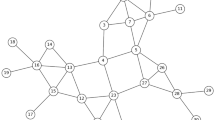Abstract
Currently, two main social policies are used by different governments to prevent the uncontrolled spreading of COVID-19, lockdowns, or “self-isolation” and borders closings. In both cases, the aim of clustering population is to localise the illness propagation in closed communities and prevent it from spread through the entire human network. In the Chapter, we discuss which mechanism better blocks the spread of the epidemic: self-quarantine in local communities induced by increasing the weights of small cliques in the human network or sharp clustering via closing of borders between arbitrary parts of the human network. In an ideal situation, when all self-isolated communities are absolutely disconnected from each other, and when the border crossings between cities and countries are totally prohibited, both protocols are equally efficient and definitely inhibit disease expansion. However, in reality, it is impossible to isolate people’s communities completely and some fraction of cross-community connections is always present. In that case, we claim that the human network clustering obtained by self-isolation better prevents the spread of the epidemic than the instant separation of the network into the clusters.
Access this chapter
Tax calculation will be finalised at checkout
Purchases are for personal use only
Similar content being viewed by others
Notes
- 1.
Outer vertices we understand as nodes connected by cross-cluster (outer) links, while inner vertices are nodes connected by in-cluster (inner) links. These notations should not be confused with outer and inner links in directed networks.
References
Pastor-Satorras R, Castellano C, Van Mieghem P, Vespignani A (2015) Epidemic processes in complex networks. Rev Mod Phys 87:925
Serrano MÁ, Boguná M (2006) Percolation and epidemic thresholds in clustered networks. Phys Rev Lett 97:088701
Keeling MJ (1999) The effects of local spatial structure on epidemiological invasions. Proc R Soc London Ser B 266:859
Moore C, Newman MEJ (2000) Epidemics and percolation in small-world networks. Phys Rev E 61:5678
Gross T, D’Lima C, Blasius B (2006) Epidemic dynamics on an adaptive network. Phys Rev Lett 96:208701
Avetisov V, Gorsky A, Nechaev S, Valba O (2019) Localization and non-ergodicity in clustered random networks. J Complex Netw CNZ026
Sala P, Rakovszky T, Verresen R, Knap M, Pollmann F (2020) Ergodicity breaking arising from Hilbert space fragmentation in dipole-conserving Hamiltonians. Phys Rev X 10:011047
Khemani V, Hermele M, Nandkishore R (2020) Localization from Hilbert space shattering: from theory to physical realizations. Phys Rev B 101:174204
Pietracaprina F, Laflorencie N. Hilbert space fragmentation and many-body localization. arXiv:1906.05709
Fortunato S (2010) Community detection in graphs. Phys Rep 486:75
Decelle A, Krzakala F, Moore C, Zdeborová L et al (2011) Asymptotic analysis of the stochastic block model for modular networks and its algorithmic applications. Phys Rev E 84:066106
Avetisov V, Gorsky A, Maslov S, Nechaev S, Valba O (2018) Phase transitions in social networks inspired by the Schelling model. Phys Rev E 98:032308
Avetisov V, Hovhannisyan M, Gorsky A, Nechaev S, Tamm M, Valba O (2016) Eigenvalue tunneling and decay of quenched random network. Phys Rev E 94:062313
Maslov S, Sneppen K (2002) Specificity and stability in topology of protein networks. Science 296:910
Viger F, Latapy M (2005) Efficient and simple generation of random simple connected graphs with prescribed degree sequence. In: Computing and combinatorics. Lecture notes computer science, vol 3595, p 440
Tamm MV, Shkarin AB, Avetisov VA, Valba OV, Nechaev SK (2014) Islands of stability in motif distributions of random networks. Phys Rev Lett 113:095701
Farkas IJ, Derényi I, Barabási A-L, Vicsek T (2001) Spectra of “real-world” graphs: beyond the semi-circle law. Phys Rev E 64:026704
Goh K-I, Kahng B, Kim D (2001) Spectra and eigenvectors of scale-free networks. Phys Rev E 64:051903
Seyed-allaei H, Bianconi G, Marsili M (2006) Scale-free networks with an exponent less than two. Phys Rev E 73:046113
Timár G, Dorogovtsev SN, Mendes JFF (2016) Scale-free networks with exponent one. Phys Rev E 94:022302
Hethcote H (2000) The mathematics of infectious diseases. SIAM Rev 42:599
Pastor-Satorras R, Vespignani A (2001) Epidemic spreading in scale-free networks. Phys Rev Lett 86:3200
Acknowledgements
We are grateful to O. Yartseva for pushing us to think about the impact of the underlying network structure on epidemic spread and to M. Tamm for valuable discussions. O.V, S.N. and A.G. acknowledge the support of the Russian Science Foundation Grant No. 21-11-00215
Author information
Authors and Affiliations
Corresponding author
Editor information
Editors and Affiliations
Rights and permissions
Copyright information
© 2021 The Author(s), under exclusive license to Springer Nature Singapore Pte Ltd.
About this chapter
Cite this chapter
Valba, O.V., Avetisov, V.A., Gorsky, A.S., Nechaev, S.K. (2021). What Social Policy Is Better: Lockdowns or Borders Closings During SARS-CoV-2 Pandemic?. In: Legach, F.a.E.I., Sharov, K.S. (eds) SARS-CoV-2 and Coronacrisis. Springer, Singapore. https://doi.org/10.1007/978-981-16-2605-0_5
Download citation
DOI: https://doi.org/10.1007/978-981-16-2605-0_5
Published:
Publisher Name: Springer, Singapore
Print ISBN: 978-981-16-2604-3
Online ISBN: 978-981-16-2605-0
eBook Packages: Social SciencesSocial Sciences (R0)




